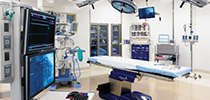Heart Rhythm Institute
Posted on January 1st, 2025
An implantable cardioverter defibrillator (ICD) is a small device that can save lives by treating dangerous heart rhythms. For individuals at risk of sudden cardiac arrest or other life-threatening arrhythmias, an ICD provides continuous monitoring and delivers a corrective shock if needed. Here’s what you need to know about the conditions it treats, the procedure to implant one, and what... Read More
Posted on December 1st, 2024
Your thyroid plays a crucial role in regulating several functions in your body, including metabolism, energy levels, and even your heart. Both hyperthyroidism (an overactive thyroid) and hypothyroidism (an underactive thyroid) can have significant effects on heart health, particularly when it comes to heart rhythm disorders. Understanding the connection between thyroid health and heart rhythm... Read More
Posted on November 1st, 2024
When your heart’s chambers don’t beat in unison, it can affect how efficiently your heart pumps blood. For some people, this leads to heart failure or worsening symptoms of an already weakened heart. That’s where a CRT pacemaker comes in.
What is a CRT pacemaker?
A CRT pacemaker, also known as cardiac resynchronization therapy, helps restore a more coordinated heartbeat. Traditional pacemakers... Read More
Posted on October 1st, 2024
Atrial fibrillation (AFib) is the most common type of heart arrhythmia, affecting millions of people worldwide. While some individuals with AFib may not experience any symptoms, others may notice a significant impact on their daily lives. It’s important to recognize these symptoms early to manage the condition and prevent serious complications, such as stroke or heart failure.
What is atrial... Read More
Posted on July 2nd, 2024
Atrial fibrillation, or AFib, is a common arrhythmia that begins in the atria, or upper chambers, of the heart. AFib causes the heart to beat irregularly, with the upper and lower chambers beating out of sync and sometimes faster than normal.
There are two basic types of AFib – paroxysmal atrial fibrillation and persistent atrial fibrillation.
Paroxysmal atrial fibrillation
In paroxysmal... Read More
Posted on May 1st, 2024
A heart rhythm disorder, also called an arrhythmia, is an irregular heartbeat. There are different types of arrhythmias, including a heartbeat that is too fast (tachycardia), too slow (bradycardia), or even abnormal heart rhythms for many other possible reasons. Symptoms of heart rhythm disorders vary, just as the types and causes of heart rhythm disorders vary.
Some irregular heartbeats do... Read More
Posted on April 1st, 2024
Atrial fibrillation, commonly called AFib, is a common heart rhythm disorder consisting of a rapid and irregular heartbeat. Symptoms can include a fluttering or pounding sensation in the chest, shortness of breath, and fatigue – all of which can be symptoms of other heart conditions as well. Thus, there can be several steps involved in diagnosing atrial fibrillation.
Medical history
For... Read More
Posted on March 1st, 2024
Left bundle branch block (LBBB) is an electrical issue in the heart. An electrical signal that begins in the right atrium triggers contractions in each heart chamber. From the right atrium, the signal travels down two bundle branches to the ventricles. In LBBB, a delay or blockage occurs on the left bundle branch that causes a delay in the left ventricle’s beat.
Electrical impulses still... Read More
Posted on January 1st, 2024
Atrial fibrillation is an irregular heartbeat that originates in the heart’s atria. The most common heart rhythm disorder, AFib can sometimes be treated by medication but often requires a procedure to remove or destroy the tissue causing the problem.
There are several different types of procedures used to treat AFib. Catheter procedures generally use heat (via radiofrequency) or cold (... Read More
Posted on December 1st, 2023
If you have recently been diagnosed with a heart rhythm disorder, you may be feeling some anxiety or fear regarding the condition. These are understandable feelings that many people experience in the weeks or months following any medical diagnosis.
These tips can help you with navigating anxiety about heart rhythm disorders.
Communicate with your medical team
We often fear the new and... Read More














